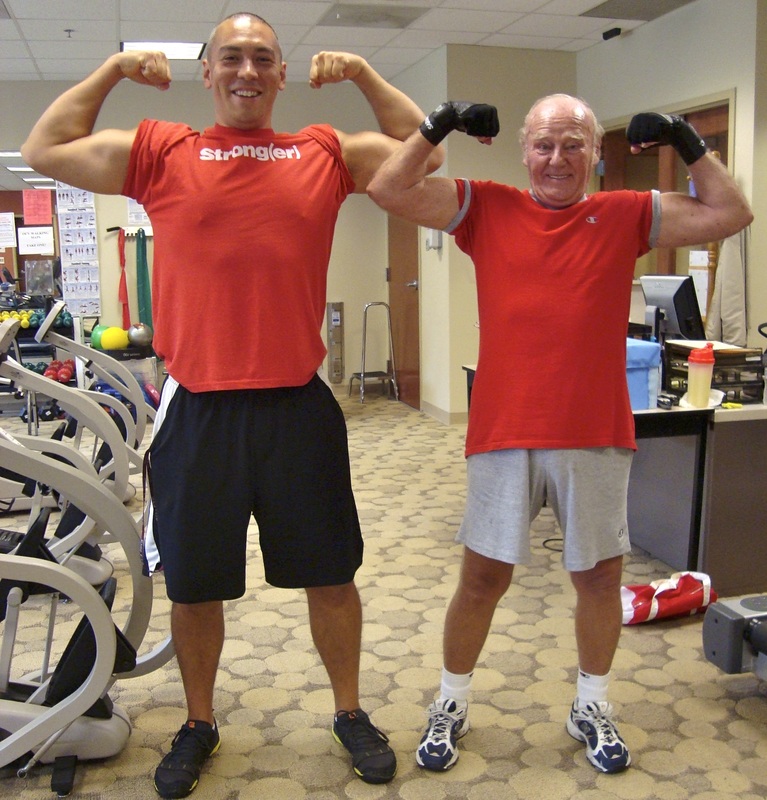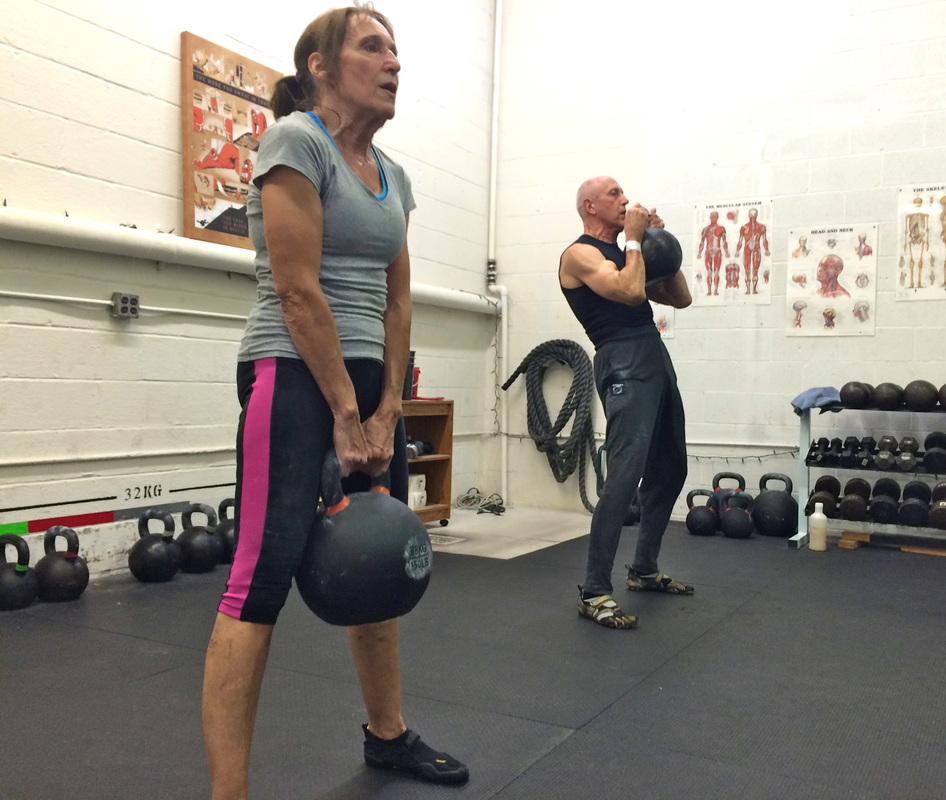 Me, Joanne and Bob Franklin Me, Joanne and Bob Franklin Master Blasters. That was the headline of the Baltimore Sun article posted at the first gym I joined when I was 15 years old. It was about a group of old guys who came to Bally's White Marsh and lifted at 5am. I don't recall the details of the article but I do remember being impressed with how strong these old guys were and their dedication to working out that they'd get up so early to lift. 15 years later I'd end up meeting one of the Master Blasters when he came to live at the retirement community I was working at. Bob Franklin and his wife Joanne joined the fitness center immediately after moving in and we soon became friends. Bob was a meathead to the core. You'd think the only thing he trained was his arms, but he did chest just as frequently. He'd do some stuff for his back, but it'd be a rainy day in hell before he did anything for his lower body. As much as I tried, I just couldn't get him to squat. Bob and I had a good relationship. It was one built on mutual respect and banter. I'd tease him about his skinny legs and he'd make fun of my shoes or something. We'd always finish our chats with a handshake where he'd try to crush grip my hand, then he'd squeeze my upper arm and tell me I was a "hell of a man" and to take care of my family. Although it's been 5 years since I was a regular employee at the community where he lived, I still teach a class there every week. And every week, Bob was there doing biceps curls with his buddy Norm. And unless I was in a rush, or he was in the middle of a set, our exchanges were virtually the same every week. It wasn't until earlier this year that Bob got sick. I didn't see him for a couple weeks, which was unusual, and then caught up with Joanne who told me that he wasn't doing well. He made a few attempts to come back to the gym, oxygen tank in tow, but it wasn't long before he was in the care center. Bob Franklin passed away yesterday at the age of 81. Bob served in the US Navy and spent 25 years in the Fire Department before retiring as a captain. He lived a life of service and he loved to lift. He was dedicated to his training, never made excuses for his age or any ailments that came with it, and because of that he enjoyed health, strength and a life that most men don't live long enough to see. Make no mistake - strength training IS the fountain of youth. It allowed Bob, and countless other men & women, to live longer and stronger. Mental faculties not included, its usually a lack of strength that separates us from independent living. When you can no longer carries groceries, reach overhead to the top cupboard, or get up off of the floor; that's when you need assistance. There is no question about it, regular exercise helps stave off the need for assisted living. Take a lesson from Bob - incorporate strength training into your life and do it for the long haul.  Robert J Franklin Oct. 19, 1934 - Aug. 1, 2016 Robert J Franklin Oct. 19, 1934 - Aug. 1, 2016 R.I.P. Mr. Franklin
0 Comments
If we look at the physical aspects of frailty as discussed in Part 1 of this article, it is plain to see that the strength, mobility and stability of the musculoskeletal system decline as we age. Exercise is the only remedy for this. There is no pill you can take to move better or be stronger. With the proper training, movement and physical strength can be restored, and maintained, at any age. If you are young, consider strength training as part of your retirement planning. If you are old, better get started now.
This article will discuss some of the most basic activities of daily living and start with exercises which should be appropriate for anyone regardless of their current physical condition. Standing up and walking will be our base ADL’s. We will assume that our hypothetical trainee can stand and walk, but not much more (injured or wheelchair bound individuals will be discussed in another article). From a strength coaches perspective, we want to strengthen standing and walking, and that means squatting. I’ve heard of “bad knees” “bad backs” and other reasons people don’t squat, but I’ve never heard anyone say that you shouldn’t get up out of a chair, be it doctor recommended or personal preference. People need to stand up before they can walk, and the exercise is called “chair stands” in senior fitness and “box squats” in powerlifting. Box squats allow for this ever important movement to be performed at varying ranges of motion. Typically, the lower into a squat that you go, the more strength, mobility and stability needs to be functioning at a higher level. A lack of any one of those things could compromise how deep a person could and should squat. For the lowest functioning individuals, we will use double stacked chairs and do bodyweight squats; for the high functioning individuals, we will do full squats with added weight. Ethel was a 92 year old woman with severe kyphosis (aka hunch back). She walked using a walker with her head looking straight down. So bad was her posture that when you past her in the hallway she would have to turn to the side to look up at you. Ethel could barely stand even from a double-stacked chair, so that’s where we started. She was challenged to not use her arms to assist, to stand a little taller at the top of each rep and descend under control (no “plopping”). A sticky note was placed on the wall in front of her to look up at and it was gradually raised it higher over the course of her program. She would probably never stand completely upright again but we countered the effect gravity was having on her with the simple cues of “stand tall” and “look up”. As her leg strength increased we moved to a single chair; first allowing use of the arms for assistance and then without. With 20 repetitions being her “max” she never needed an additional load. Compare this to Frank, a 85 year old man who exercised regularly ever since he left the military 50 years ago. He could squat to below parallel and his range of motion was limited only by arthritic knees and his preference for biceps curls instead. He could also maintain proper form under a load. Although shoulder mobility might prevent him from holding a barbell behind his back as in a true powerlifting squat, dumbbells and kettlebells could be held as a front or goblet squat. Frank has more options available to him for progression as he could safely increase weight, repetitions and on good days even try to go lower (albeit with less weight). By squatting deep and with a load, we can improve the strength, mobility and stability qualities required to stand up and walk. How deep and with how much load is a completely individual thing and hormesis (a fancy word found in chapter 1 of Strong Medicine that refers to “dosage”) can only be found by the fitness professional, someone who is trained in squatting mechanics, exercise prescription and coaching techniques. The squat is a basic human movement that you will need to do for the rest of your life if you plan to walk. Performing this exercise regularly will maintain and develop both mobility and stability. And by loading the squat we access one of two basic exercises that allow for the heaviest load to be used. The other exercise in which we use the heaviest loads in is the deadlift. This is where the real bone building happens. The deadlift and the partial deadlift allow for the heaviest weights to be used and our primary objective is to use heavier weights. It’s a pure strength movement. It’s based on the hip hinge and contrary to the plea of “bad backs” (which deadlifts will make into “good backs”) there is a deadlift variation that is appropriate for anyone. That is not a call to add load but everyone should be “hinging”. The hip hinge should be taught before the squat even, especially considering that squatting “starts” at the hips. Another benefit to the deadlift is that it has a shorter range of motion, making it safer for more people. It is also a less technical movement making it easier to learn. A good coach can teach the hip hinge and tell when individuals are ready to progress. Again, progressions can be made in the form of additional load or greater ROM. As a rule, I use the length of hand to determine where people can pull from. If technique can be maintained to a point where the crease of the wrist passes lets say, the knee, then the trainee can pull from there. Setting up at this height will allow for a 2-3 inch “buffer” so the lifter is not pulling from his/her end-ROM. A brief note on set up. Any powerlifter reading this will know how to set up a power cage for rack pulls. To pretty much everyone else reading this those last few words are foreign, especially to your average 60+ year old exerciser. This is unknown territory that can be downright frightening to some people. Fortunately there are machines that allow set up for partial deadlifts with adjustments as simple as pressing a button. Many senior centers are equipped with pneumatic or computerized machines to allow user friendly solutions to older adults. Unfortunately you will see few “racks” in these centers. We can speculate on why that is (i.e. liability, funding, misuse, lack of qualified personnel, etc) or we can make a call to action for fitness centers to offer deadlifting options. The importance of weightbearing exercise to combat sarcopenia, osteoporosis and frailty syndrome cannot be overstated. Partial range of motion deadlifts must be made available to the population who are at most at risk if we are to reinforce our position against frailty. If this means expensive equipment or powerlifting coaches posted by the powercages in every senior center, so be it. This is an issue that we will all face sooner or later - old age and everything that comes with it. So much of senior fitness boils down to standing tall, and standing strong. Just the right balance between mobility and stability. Strengthening the posterior and stretching the anterior. When properly programmed the squat and the deadlift address both of those components and these two exercises alone give people a simple approach to not just exercising, but improving the quality of their lives. Activities of daily living could not be better support than through these exercises. In the oddest way, people are meant to be weight lifters and when the powerlifting community intersects with the retirement community, geriatric health and senior fitness flourish. |
AuthorDan Cenidoza, BS, CSCS ArchivesCategories |


 RSS Feed
RSS Feed